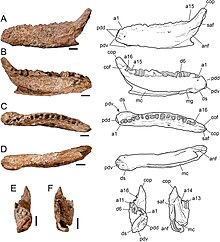Ampelognathus
| Ampelognathus Temporal range: Late Cretaceous,
| |
|---|---|

| |
| Holotype dentary | |
| Scientific classification | |
| Domain: | Eukaryota |
| Kingdom: | Animalia |
| Phylum: | Chordata |
| Clade: | Dinosauria |
| Clade: | †Ornithischia |
| Clade: | †Neornithischia |
| Clade: | †Cerapoda |
| Clade: | †Ornithopoda |
| Genus: | †Ampelognathus |
| Species: | †A. coheni
|
| Binomial name | |
| †Ampelognathus coheni Tykoski, Contreras & Noto, 2023
| |
Ampelognathus (meaning "grapevine jaw") is a genus of ornithopod dinosaur from the Late Cretaceous (Cenomanian) Lewisville Formation of Texas. The type species is Ampelognathus coheni.[1]
Discovery and naming
[edit]The Ampelognathus holotype, DMNH 2021-05-02, was found in sediments of the Lewisville Formation of the Woodbine Group (Arlington or Tarrant Member), dated to the Cenomanian age of the Late Cretaceous period, in the Grapevine Lake emergency spillway of Tarrant County in Texas, United States. The specimen consists of a single, nearly-complete left dentary. It was found 100 metres (330 ft) away from the holotype of the enantiornithean bird Flexomornis.[1][2]
In 2023, Tykoski, Contreras & Noto described Ampelognathus coheni as a new genus and species of ornithopod dinosaur. The generic name, "Ampelognathus", combines the Greek words "ampelos", meaning "grapevine", and "gnathos", meaning "jaw", in reference to the type locality in the emergency spillway of Grapevine Lake in Texas. The specific name, "coheni", honors Murray Cohen, the discoverer of the holotype specimen.[1]
Phylogeny
[edit]In their phylogenetic analyses, Tykoski, Contreras & Noto (2023) recovered as a basal member of the Ornithopoda, as the sister taxon to the clade containing Thescelosaurus and the Iguanodontia. Ampelognathus was thus likely more closely related to iguanodontians than to the morphologically similar "hypsilophodonts". The results of their phylogenetic analyses are shown in the cladogram below:[1]
In 2024, Fonseca et al. comprehensively reanalyzed the interrelationships of early ornithischians, but were unable to include Ampelognathus in their phylogenetic analysis as the paper describing it was published after their data collection phase was completed. However, they were able to comment on its relationships, stating that certain traits supported it as a member of Rhabdodontomorpha, but a more basal member than either Tenontosauridae or Rhabdodontoidea.[3]
References
[edit]- ^ a b c d Tykoski, Ronald S.; Contreras, Dori L.; Noto, Christopher (2023-10-13). "The first small-bodied ornithopod dinosaur from the Lewisville Formation (middle Cenomanian) of Texas". Journal of Vertebrate Paleontology. doi:10.1080/02724634.2023.2257238. ISSN 0272-4634.
- ^ Tykoski, R.S.; Fiorillo, A.R. (January 2010). ""An enantiornithine bird from the lower middle Cenomanian of Texas". Journal of Vertebrate Paleontology. 30 (1): 288–292. Bibcode:2010JVPal..30..288T. doi:10.1080/02724630903416068. S2CID 84037461.
- ^ Fonseca, André O.; Reid, Iain J.; Venner, Alexander; Duncan, Ruairidh J.; Garcia, Mauricio S.; Müller, Rodrigo T. (2024-12-31). "A comprehensive phylogenetic analysis on early ornithischian evolution". Journal of Systematic Palaeontology. 22 (1). Bibcode:2024JSPal..2246577F. doi:10.1080/14772019.2024.2346577. ISSN 1477-2019.

